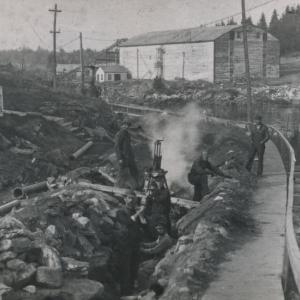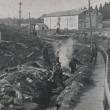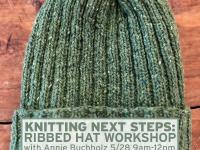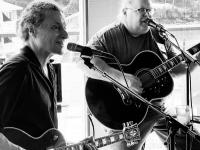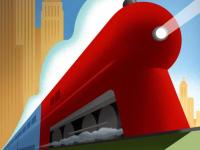Mill Cove Ice Company, Part I
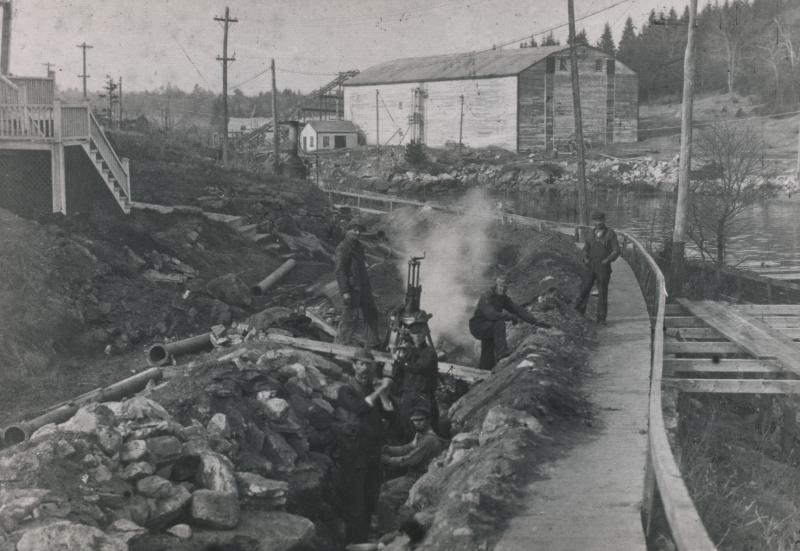 By late November 1912 Elbridge Giles's waterline pipe-laying crew had rounded Mill Cove and was headed for West Harbor. The photo's largest feature is the Mill Cove Ice Company's icehouse, with its elevator rising to the top. The site's gentle hill was blasted level and covered with condominiums in the late 1980s. The 1900s ice run to the deepwater wharf is apparent; it looks like a little sidewalk running outside the obvious sidewalk. The poles in the cove constitute the fish weir of Clarence or Charles Hodgdon, meant to trap herring and alewives. Courtesy of Barbara Rumsey
By late November 1912 Elbridge Giles's waterline pipe-laying crew had rounded Mill Cove and was headed for West Harbor. The photo's largest feature is the Mill Cove Ice Company's icehouse, with its elevator rising to the top. The site's gentle hill was blasted level and covered with condominiums in the late 1980s. The 1900s ice run to the deepwater wharf is apparent; it looks like a little sidewalk running outside the obvious sidewalk. The poles in the cove constitute the fish weir of Clarence or Charles Hodgdon, meant to trap herring and alewives. Courtesy of Barbara Rumsey
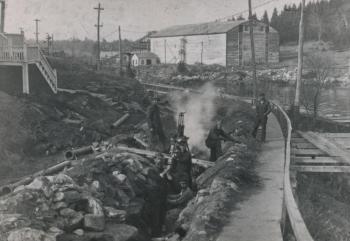 By late November 1912 Elbridge Giles's waterline pipe-laying crew had rounded Mill Cove and was headed for West Harbor. The photo's largest feature is the Mill Cove Ice Company's icehouse, with its elevator rising to the top. The site's gentle hill was blasted level and covered with condominiums in the late 1980s. The 1900s ice run to the deepwater wharf is apparent; it looks like a little sidewalk running outside the obvious sidewalk. The poles in the cove constitute the fish weir of Clarence or Charles Hodgdon, meant to trap herring and alewives. Courtesy of Barbara Rumsey
By late November 1912 Elbridge Giles's waterline pipe-laying crew had rounded Mill Cove and was headed for West Harbor. The photo's largest feature is the Mill Cove Ice Company's icehouse, with its elevator rising to the top. The site's gentle hill was blasted level and covered with condominiums in the late 1980s. The 1900s ice run to the deepwater wharf is apparent; it looks like a little sidewalk running outside the obvious sidewalk. The poles in the cove constitute the fish weir of Clarence or Charles Hodgdon, meant to trap herring and alewives. Courtesy of Barbara Rumsey
I've written any number of articles that mention or were devoted to iceworks, businesses that were once prevalent region-wide from about 1870 to the 1910s.
Historical society articles covered in depth those iceworks at West Harbor, Back Narrows, Appalachee, Knickerbocker, Meadow Cove, and Lobster Cove. About 1900, more men were employed nationwide in icecutting than in any other job. Our region swarmed with activity in the coldest months, with three- and four-masted schooners jostling in region waters for loads of ice to take south. The vessels continued taking ice cargoes from the icehouses well into warm weather since the buildings were insulated with straw and sawdust.
Though artificially created ice gained in popularity toward the late 1890s, the naturally made ice trade still did fairly well in the region for succeeding decades, then dwindled rapidly in the 1920s to end about 1940. In those last decades, local hotels, summer colonies, and farmers were the main surviving users here of locally cut ice, often having their own little ponds. Or, if you had no electricity, as was the case in parts of town throughout the early 1940s, an icebox remained desirable or necessary. And some families were so used to the old ways that they didn't want to rely on newfangled methods, like electricity. It could be unreliable and costly, having to pay a utility, buy a refrigerator, and run wires. Cutting and storing your own ice was cheap. Many people still wanted "God's ice."
The Boothbay Register
The Register acted as a community barometer and town crier for the ice business. It customarily reported the depth of the ice, the poundage in icehouses, the great number of men at work, anecdotes and accidents, and the vessels at anchor waiting to load. The purity of some iceworks' product was proven by bringing a thick cake (normally none were cut under 12 inches) to the Register office and reading the paper through it. It was an exciting but worrisome time since a hard winter spelled prosperity while a mild winter signaled slim pickings for local people. In 1890, region iceworks employed 650 local men on the ice. There were only 3,400 people in Boothbay and the Harbor; 650, a fifth of the population, could have been all the males from eight to 80, grateful for paid labor in the coldest months. As our "ice age" headed toward its end, the industry was reliant on bad (warm) weather elsewhere, which sent men scurrying to get mothballed iceworks in shape.
The Early Reed Mill
In the mid-1700s, the Reeds dammed the low watery expanse north and east of its outlet into Mill Cove, once Reed's Cove. When flooded, it transformed the Meadow into a lake extending to the location of the schools and the YMCA on Route 27. By 1828 the mill was no longer functioning, off the tax rolls, and the water could move unimpeded.
As long as the Reed millsite flooded the Meadow, the old roads to the Center were on higher ground, bowing out to the east to get around the water. One of those roads ran straight north from Montgomery Road up through Alden Jordan's Red Hawk Reach, and the other ran generally northeast on Eastern Avenue to the Delano and Wylie house area (across from intersection of Rte. 96 and Eastern Ave) where it backed to the northwest to Hackmatack Road; in late years that northwest stretch was called Back Center Road by those who walked it.
In the 1830s, the new road we now traverse running through the Meadow was accepted. I guess the Boothbay selectmen thought they were safe from a damming mill after the Reeds idled it for a few years. An 1859 article to raise the road implies there was still problems — there always is with a big sponge like the Meadow.
Luther Maddocks started, or was involved in, many iceworks in what became Boothbay Harbor. He often sold out soon after starting a venture, whether fish or ice, only to begin another almost immediately. He started an iceworks at Echo Lake at Lobster Cove in 1880, at Mill Cove two years later, had an interest in Appalachee's for a while and West Harbor's after 1900, and he acquired an interest in Mill Cove again after 1905.
Next time I'll cover Luther Maddocks's 1882 iceworks at Mill Cove and the struggles with the consequent flooding of the region's major road.
Event Date
Address
United States

